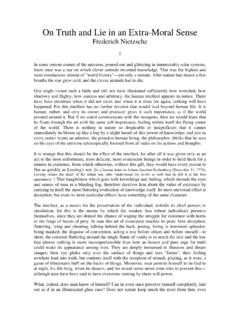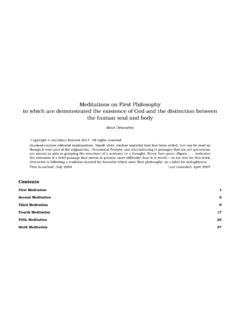Transcription of Helping Your Child Transition from Foster Care to Adoption
1 Children s Bureau/ACYF/ | Email: | S INSIDET alking with children about the Transition to adoptionHelping children understand and copePromoting attachmentConclusion ResourcesReferencesFACTSHEET FOR FAMILIESJuly 2018If you are a Foster parent adopting a Child , children, or youth currently in your care, you have a pivotal role in Helping them adjust to Adoption . The Adoption process is an ongoing journey that continues well past the day the Adoption is finalized. There are several ways you can ease the Transition and many supports available to help you in this important work. This factsheet discusses common issues that come up for children and families during the Foster -to- Adoption process, how to support your Child or youth through the Transition , and resources available for help. Talking With Children About the Transition to AdoptionThe Transition to Adoption is a gradual process for all involved.
2 The adjustment period can be a vulnerable time as your Child begins to understand they are a permanent member of your family and will not return to live with their birth family. Some children may feel relief as plans are finalized while others may feel a deep sense of loss. Listening carefully to your Child throughout the Adoption process and creating a safe environment for sharing feelings can help build trust and ease the Transition . Helping Your Child Transition From Foster Care to Adoption Your Child Transition From Foster Care to Adoption2 This material may be freely reproduced and distributed. However, when doing so, please credit Child Welfare Information Gateway. This publication is available online at Plan regular events and activities where the focus isnot on Adoption but on building family memories andrelationships. Develop relationships with other families who maybe fostering children or who have adopted childrenthey fostered.
3 It helps to see families that look similarand share common experiences. Sharing commonexperiences, challenges, and successes may ease thefeeling of being isolated or different. The Adoption of a Child in Foster care by caregivers is very common. According to the most recent Federal data, over half the children adopted from Foster care during fiscal year 2016 (52 percent) were adopted by their Foster parents ( ).Finding HelpThe core issues of Adoption including loss, rejection, and identity may surface at different points in your Child s life, depending on events and his or her developmental stage. The Transition to Adoption is most successful when families can access a wide variety of support services. Child Welfare Information Gateway offers several resources related to Adoption support and preservation: About Postadoption Services and Support,an Information Gateway webpage: Accessing Adoption Support and Preservation Services, a factsheet for families from ChildWelfare Information Gateway: National Foster Care & Adoption Directory(NFCAD), Adoption and Foster care resourcesby State ( ) anda mobile app ( ) that connects users to Foster careand Adoption agencies, Adoption educationand training organizations, Adoption supportgroups, and related professionals Support for Parents Who Adopt From FosterCare, an AdoptUSKids webpage: is important to share stories in a developmentally appropriate manner about your Child s background and/or placement history and how he or she came to be adopted by you.
4 Honor this as an important part of his or her identity. Adopted children and youth often have questions about their birth family and the reasons they are no longer able to live with them. It is essential to validate your Child s experiences and feelings and tell the truth , even when difficult. There are several ways adoptive parents and siblings can help children or youth adjust to the Adoption and feel more secure as a member of the family: You can help your Child understand that Adoption doesnot have to mean replacing or no longer loving theimportant people in his or her life. Instead, your childis growing the family that will be a source of love andsupport. Remain truthful as you share information. If your childwas adopted at a very young age, perhaps you canlet them know if this was the case that their birthmother was not able to provide care and asked youand your family to do so. Encourage open discussion about the people whomatter to your Child and find ways to stay in contactwith them.
5 Create traditions, activities, events, or anniversariesto recognize and acknowledge the Adoption as amilestone for your family. Be sure to listen to andinvolve your Child in planning these events. Manychildren feel very special on their Adoption day, whileothers have conflicting feelings of loyalty and loss. It isnormal for a Child to have mixed Your Child Transition From Foster Care to Adoption3 Children and youth learn best through repetition. Conversation about the differences between Foster care and Adoption may need to be introduced a number of times before a Child fully understands. Integrating these conversations during moments of connection with your Child can help Foster bonding and attachment and help him or her explore feelings about Adoption and you. Below are some ideas to encourage that process: Help your Child talk about the perceived differencein his or her own words. Ask open-ended questions,such as, How do you think being adopted is differentfrom being in Foster care?
6 Or What do you think thebiggest difference is, now that you re adopted? Help your Child draw analogies to something in his orher life. For instance, you might say, This is like thetime To help children understand one of the key differencesbetween Foster care and Adoption , you might remindthem that Adoption makes them a forever memberof your family and that they will always be your Child ,even when they are grown up. Reading a children sbook like Love You forever ( ) can be helpful. An older Child may seek to understand his or herpersonal story and the reasons behind the fostercare and Adoption . Be honest if you don t have allthe details or don t know what happened regardingyour Child s birth family. You can ask your Child oryouth about their understanding of the aware of your reactions and make sure you arecommunicating safety and acceptance with whatever the Conversation to Your Child s Developmental AgeYour Child s understanding of Adoption will depend on his or her developmental stage.
7 The following resources may help guide your conversations: The Center for Adoption Support andEducation ( ) developed a series offactsheets on Helping children adjust toadoption based on their developmentalage. The factsheets address both basic anddifficult Adoption -related topics for youngerchildren, adolescents, and older teens ( ). The digital magazine and website Adoptive Families has several articles about how to talkto your adopted Child throughout the transitionprocess ( ). The tip sheet, Talking With Older Youth About Adoption , offers suggestions for startingconversations with teens and topics to explore( ). Child Welfare Information Gateway s webpage,Talking About Adoption ( ) includes additional age-specific information and material may be freely reproduced and distributed. However, when doing so, please credit Child Welfare Information Gateway. This publication is available online at 2018htp1s: i h24 This material may be freely reproduced and distributed.
8 However, when doing so, please credit Child Welfare Information Gateway. This publication is available online at Children Understand and CopeWhen children or youth spend extended periods in out-of-home care, memories of significant events and people can be lost. Children may lose their sense of self: who they are, where they have lived, the people they have lived with, where they went to school, memories of favorite items ( , stuffed animals or blankets), and more. You can help your Child review and understand previous life experiences to clarify what happened in the past and help integrate those experiences so your Child will have greater self-understanding. Acknowledging your Child s past, addressing potential issues of trauma, grief, and loss, and recognizing and embracing racial and cultural identity are all part of a healthy Transition Child may experience a range of emotions and require additional support at different stages.
9 Your Child welfare agency, caseworker, or Adoption specialist can help you identify appropriate and available services and supports. Many organizations specialize in working with families transitioning to Adoption . If you seek counseling or mental health treatment, it is important to seek a therapist who is competent in Adoption -related issues. ( ) provides specialized mental health services for adoptive and Foster families and offers a nationwide directory of Adoption -competent professionals ( ). Child Welfare Information Gateway s factsheet for families, Selecting and Working With a Therapist Skilled in Adoption ( ), provides guidance on seeking professional the Integration ProcessWhen possible and safe, seek to maintain connections with your Child s birth family. Your Child or youth comes with a unique story and identity that will always be a part of who they are regardless of how old they were when they first moved into your home.
10 While children can be resilient and form new attachments to adults who are meeting their needs, recognizing and embracing their past can help them make sense of their personal story and identity and ease the integration process into your family. There are specific steps that can help children integrate existing relationships with the important people in their lives while promoting connections with new family members. Integration can help children cope with the potentially painful realities of separation from their birth family. Children who have experienced abuse, neglect, and related trauma may have a harder time managing transitions. Child Welfare Information Gateway has several factsheets for families to help address some of these concerns: Parenting a Child Who Has Experienced Trauma ( ) Parenting a Child Who Has Experienced Abuse or Neglect ( ) Parenting a Child Who Has Been Sexually Abused: A Guide for Foster and Adoptive Parents ( pubs/f-abused)Both the National Child Traumatic Stress Network ( ) and the Child Trauma Academy ( ) websites provide related resources.


















